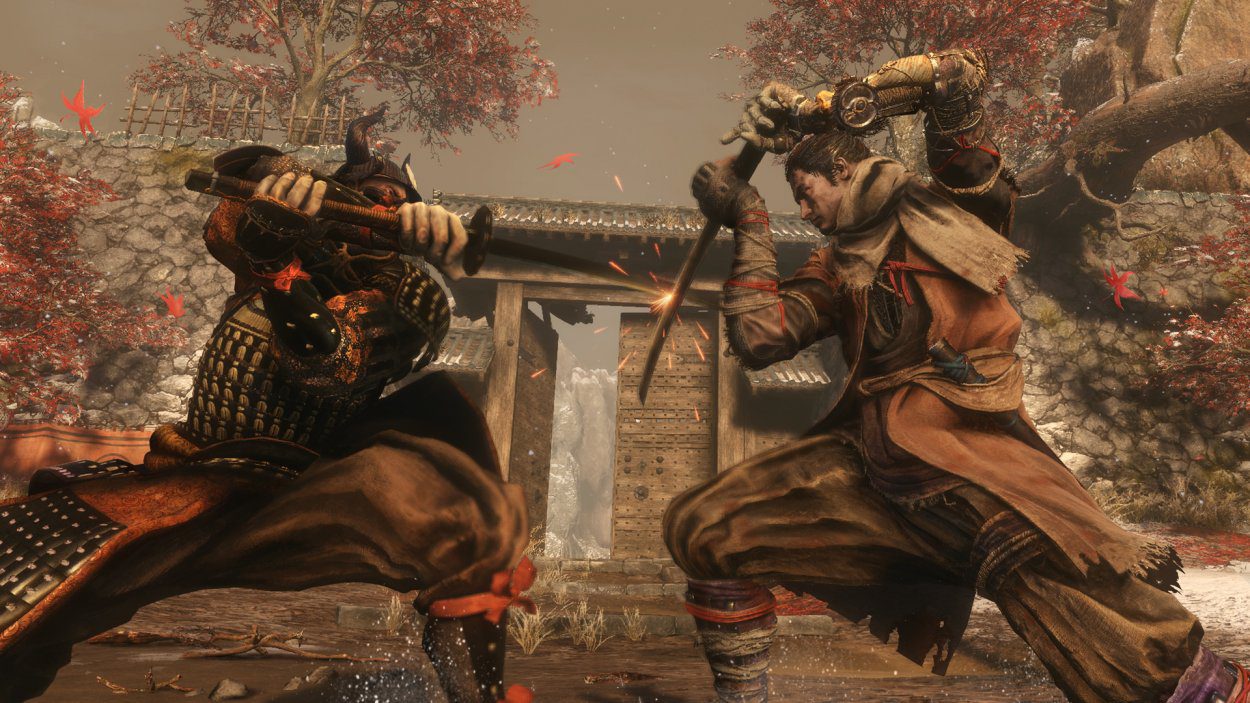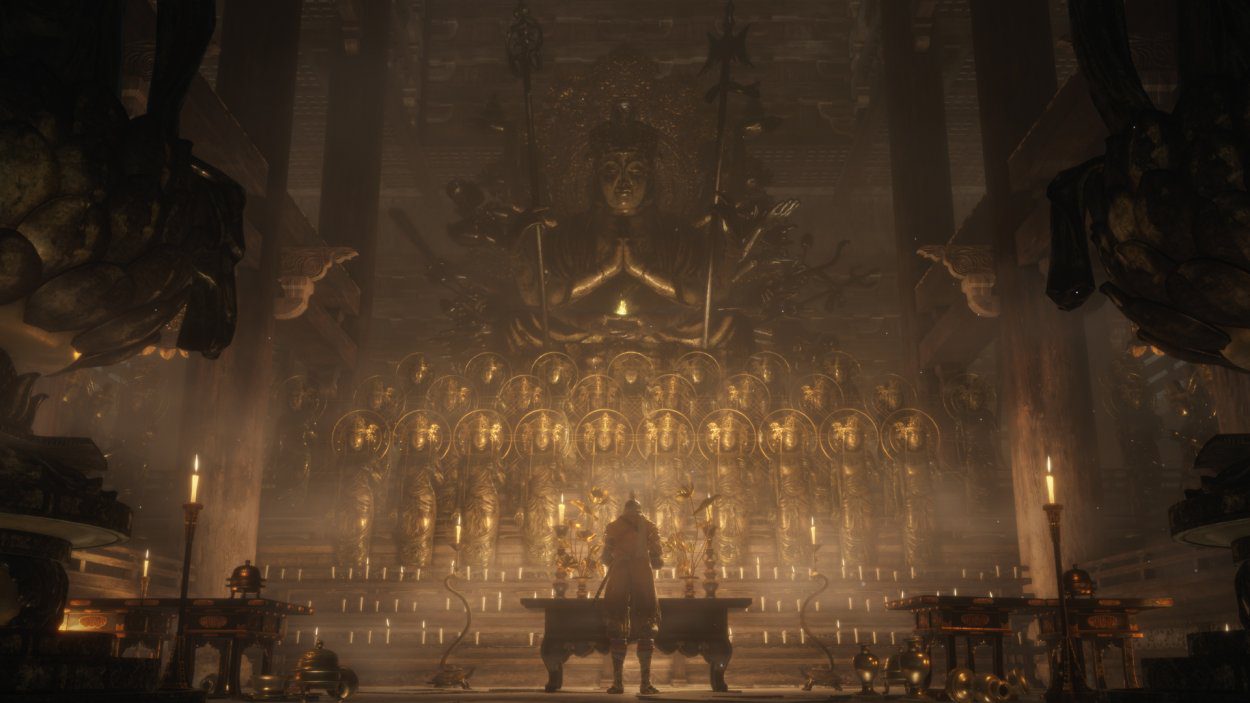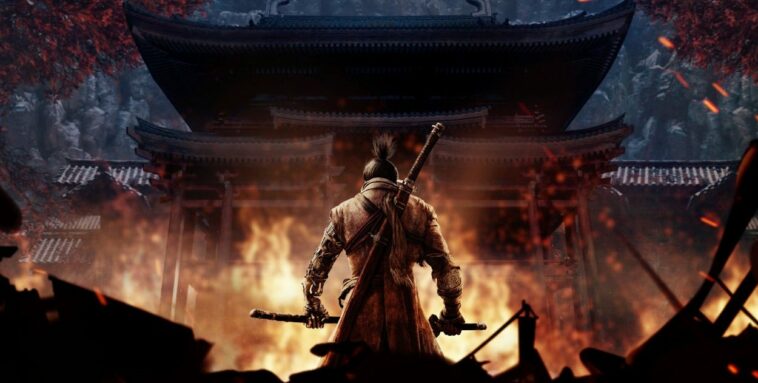To say that Sekiro: Shadows Die Twice is difficult is an almost comically bad understatement. At this point, From Software have more or less cornered the market on boundary-pushing action RPG titles that put players in situations most other developers wouldn’t even dream of. The thing about all of their SoulsBorne titles, though, is that they are difficult in a way that teaches. They punish the player for making the wrong move, making them get better and better until they overcome a challenge that seems insurmountable. The reason these games are so popular is for that exact feeling of euphoria. The first time I played Dark Souls, the Asylum demon felt harder than some other games’ final bosses. Hell, almost every boss felt that way. But on my second playthrough, I was not only stronger, but smarter as well. I knew what to look out for. I knew when to dodge, and when to attack.
Look, what I’m saying is that I’m a confirmed fan of From Software. I loved the Dark Souls trilogy (3 is my favorite, fight me) and have grown to appreciate the unique way they approach difficulty. It’s a game design style often imitated but only understood by a few, such as Hollow Knight or Hotline Miami.
So imagine when my surprise when Sekiro came along and completely kicked my ass.

It’s worth noting that this is a different beast entirely from the SoulsBorne games. Sure, the difficulty is always at high. Sure, the world is more interconnected than you might think. Sure, death is punishing. Sure, combat is all about positioning and timing. Viewed from a distance, one could easily mistake this for being Dark Souls: This Time You’re a Ninja. But examining it more closely, this game is a marriage of the timing based Souls Borne combat and spectacle fighters like Devil May Cry, Ninja Gaiden, and Bayonetta. And there are stealth elements too.
Some context: you, a man most people call Wolf, are a Shinobi. Having lost your real family on the battlefield of feudal Japan, you were adopted at a young age by a mighty warrior named Owl and trained in the way of the Shinobi, a fighting style that emphasizes relentless attack and parrying to wear away at an enemy’s posture. You have been tasked with guarding the Divine Heir, a child who holds Dragon’s Blood in their veins. The blood gives its host immortality, and because of Wolf’s connection to the Heir, he is also unable to die. After a coup that sparks a civil war, Wolf’s arm is cut off and he awakens to another, older Shinobi who tells him the Divine Heir has been taken by people who would use the Dragon’s Blood for nefarious purposes. He gives you the Shinobi Prosthetic and you set off to free the Divine Heir.
Yes, to my great surprise, there is actually a more traditionally told story! Cutscenes with dialogue that says things related to the plot instead of cryptic phrases! In all seriousness, the story is more involved than other recent From games, but there is still the aspect of storytelling through item descriptions and the environment. It’s a nice mixture of straight-ahead plot and the more nuanced world-building From is known for. It’s not the most amazing story in the world, but it goes to some interesting places and encompasses some interesting themes.
The aforementioned Shinobi Prosthetic is a replacement arm that comes equipped with a grappling hook. Wolf can not only run extremely fast and jump around like the floor is lava, but he can propel himself through the air using this upgrade that you get very early on. It feels extremely liberating, and makes skulking about the rooftops while an unaware enemy opens themselves up for a stealth kill extremely satisfying. But the Prosthetic also has secondary functions: you can attack upgradeable tools found in the world that all perform different functions, from Shuriken that can knock enemies out of the air to a metal umbrella that blocks all physical attacks. Both the movement options and the supplementary combat moves the Prosthetic gives you go a long way towards making you really feel like a master ninja.
As fun and powerful as those tools are, they are only meant to compliment the already extensive pool of moves Wolf has at his disposal. Wolf can slash, jump off of enemies, dodge, and deflect incoming attacks. But if you’re really good at timing, you can parry the attacks instead, a move that builds up an enemy’s Posture damage and prevents buildup of yours. Posture is similar to Poise from previous SoulsBorne games, except here it is an entirely central feature to combat. Basically, once your Posture breaks, you flinch for a few seconds, leaving you wide open to an enemy attack. But if an enemy’s Posture breaks, they’re open to a deathblow, a move that instantly kills regardless of the enemy’s health. Let it be known now: Posture damage in this game is not optional. Many, many enemies in the game have massive health pools, while your own disappears if hit just a few times.
Posture lends combat to a nice feeling of momentum within a given fight. Memorize an enemy’s movement pattern, and chances are they’ll go down in no time at all. Indeed it is supremely satisfying to perfectly parry every one of an adversary’s blows before finishing them off by impaling their neck with your sword. This is much easier said than done, however. Making boneheaded choices like fighting more than maybe two enemies at once is more or less a death sentence, unless you’re able to read each individual’s attacks and somehow block them perfectly. Then there’s the margin for error, which is to say, this game punishes you hard for mistakes. Improperly timing even one parry can lead to you losing most if not all of your health bar because of how aggressive the enemies are. It’s absolutely critical to know precisely when to do what with a given enemy, and it makes overcoming even common encounters a breathless, thrilling affair because you know that failure can come swiftly and at any time.

Common enemies are relatively easy to lay waste to once you learn their patterns, but scattered throughout the world are named enemies, essentially mini-bosses, that act as skill checks. And make no mistake, they are just that. After the first couple, they start pulling no punches, with one in particular early on having already become infamous among the game’s community. More often than not, they have a particular weakness that, once you learn their moves and how to counter them, makes it far easier to bring them down than they at first appear. The aforementioned infamous early encounter took me forever. In the area before him were at least eight enemies, and it got to the point where I could stealth kill every single one without them noticing. Then I would confront the boss and promptly die, and was forced to redo the area again.
The key is to watch danger indicators. Most mini-bosses (and bosses) have extremely powerful attacks that can’t be deflected and instead must be countered another way. Sometimes this means a sweeping attack that you must jump over (and inflict massive Posture damage when you jump off them). Other times, it’s a thrust attack you have to use a move called Mikri counter to punish (Mikri counter is a move you obtain very early on. Essentially you dodge towards a charging enemy while leaving the control stick in neutral and Wolf side steps and stomps on their weapon—it took me quite a while to learn, but once I did, I was able to nail the timing and no matter what, it was always satisfying to pull off). And make no mistake, the tells for what moves an enemy is about to do is extremely small, sometimes a flash of the blade, other times simply what stance they’re taking. And learning what tell means what is often very tough. But eventually, you either learn or stop playing. Eventually, with this early mini-boss, after having died to him probably a good 20-25 times, something clicked, and I was able to counter every single move he threw at me perfectly. A fight that once seemed impossible was over in less than a minute.
It helps that the game’s art style accommodates this method of learning how to best enemies. Every enemy in the game is very well designed, with specific animations that go a long way toward feeding you information in the blink of an eye. But all that aside, this is a very good looking game. There’s an astounding variety everywhere you go. One moment, you might be fighting monks in verdant green mountains, and the next you might be fighting emaciated gunmen in a poisonous underground lake. You never know quite what to expect around each corner, leading to a sense of excitement that comes from exploration. And if you’re worried that From has gone for more realistic enemy designs, rest easy- there are several surprises scattered throughout the world that will disturb you (one of which actually made me yell). The focus is on one on one sword duels, but there’s some surprising horror, and creature design sprinkled liberally throughout.
The world is littered with items that make your life a fraction of a percentage easier. Sometimes it might be a fistful of ash, which can temporarily blind enemies, leaving them open to a few attacks. Other times it’s something infinitely more useful, like an item that increases your replenishable healing or health buffs. Then there’s the upgrade system. Each time you level up, you gain skill points that can be spent on passive buffs and special combat moves. Suffice it to say, Sekiro does a fantastic job of making the player want to explore the world to its fullest extent.
Here we come to the main attraction: the bosses. Mini-bosses are already extremely challenging, but the bosses in this game take everything to the next level. Most of them are merely one on one duels against a fellow humanoid opponent (with a few exceptions, particularly one near the end that feels like something straight out of Dark Souls). An early encounter seems deceptively easy—t’s an older woman who, right when you think you’re in for a cakewalk, starts leaping around the arena pelting you with needles and sweeping your legs out from under you. Every boss will push the limits of everything you’ve learned up to that point in the game, and that’s not an understatement. And the further the game goes on, the more you’ll have to rely on mastering each boss’s move set so you can counter each move, which WILL shave off at least half your life bar if you’re not careful. And don’t get me wrong: I got mad while playing this. Some bosses would take me several days to surmount. I would put the game down, mad as all hell, but I couldn’t get the game out of my head. I would inevitably return. And eventually, I would bring down the boss’s multiple health bars and deliver the final deathblow (which, it should be pointed out, is immensely satisfying as it usually results in a badass animation, followed by a fountain of blood that would make Tarantino squeal in delight). If you’re anything like me, there will be times where you forget to breathe because of the zen-like state you enter while fighting the aggressive and punishing bosses (the final encounter in the game made me yell a very explicit obscenity once I managed to deliver the final deathblow).

While overcoming the many challenges the game throws at you is as satisfying as can be, to say the game is flawless would be incorrect, minor though the reported flaws are. For one thing, there’s a status ailment called Terror. There are only a few enemies in the game who can inflict this upon you, but each one feels broken until you find a specific Prosthetic upgrade that completely breaks the encounters in your favor. Terror builds up even if you perfectly parry an attack, and does vitality damage. So even if you’re playing according to the game’s rules, you still get hurt. Once you find the aforementioned item, these encounters stop being challenging and feel more rote. Then there’s a mechanic called Dragon Rot. The subtitle of Shadows Die Twice refers to the fact that you can resurrect yourself once if you bite the dust (you eventually gain further resurrective powers later on).
If you die again before killing the enemy that killed you the first time, it’s back to the last checkpoint, with all the other enemies you killed having come back, you losing half of your current money and experience. If you die enough, you lose the percent chance to get what is referred to as “Unseen Aid”, and it also makes NPCs sick, sometimes closing out entire questlines until you cure the sickness. Unseen Aid essentially makes you lose nothing on death, but the max chance for it is so low that it can’t be relied upon if you’re walking around with close to full experience and a heavy wallet. But the fact that it makes NPCs sick and can close off quest paths until you use a costly in-game item to fix the sickness makes death feel even more punishing than it already is. From a storytelling and thematic perspective, it’s an interesting mechanic, but from a gameplay perspective, it comes across as pointlessly punishing. Finally, to go back to Terror, the enemies that inflict it are almost always spirits of some sort, and named enemies that have two health bars just like all the other mini-bosses. But the thing is that most other mini bosses allow you the opportunity to stealth kill one of their life bars, evening the odds somewhat in your favor. These spirit enemies, though, cannot be snuck up upon. It feels entirely arbitrary and is never given any real in-game reason for why the rules are broken like this.
It’s tough to say what kind of person would enjoy this game, because even fans of previous SoulsBorne games have struggled to progress and grasp the game’s intricate combat system. Sekiro is indeed a tough game, but in the sense that it punishes the player for not making use of the systems the way the game lays them out. There will be times where you’re furious at the game and might even think it’s cheap; on more than one occasion I would attempt healing only to be punished by the boss who was in the middle of attacking. But therein lies the brilliance- learning. The split-second reaction time required to take down the game’s fiercest foes leads to a state of extreme focus, one that you barely even think about as you’re doing it. In this way, the game makes you feel like a master swordsman, who from a character perspective, relies on their instincts and reactions to win battles. Eventually, everything clicks and you’ll take out a boss who previously gave you trouble while using almost no healing and suffering no deaths. But even outside the combat, the game weaves a neat story about immortality gone wrong. It has a varied world with upgrades aplenty and more than its fair share of terrifically designed enemies.
The best thing I can say for the game is that it taught me to be a better player. I didn’t beat the game by cheesing, or by looking up easy strategies. I beat it because the game taught me how to do so, all without saying a word. The very first boss fight in the game is one you’re going to lose one way or the other. Even if you manage to get their health down to zero, a cutscene triggers that leads to your loss due to story reasons. But ignoring that, you’re going to lose it because it throws you against an enemy that you aren’t prepared for. The enemy in question strikes with speed, has a huge variety of moves with extremely small windows of opportunity to counter, and also comes equipped with a bow in case you thought running away would help.
There’s a rematch, though, about halfway through the game, and he has the same move set in his first form. To overcome him, you have to learn the moves he throws at you. When I did finally beat him—even past his beefed-up second form—realized that even though my attack power was greater than in the beginning, I had much more health and a wider variety of tools at my disposal. I only came out the other side because I had gotten better at the game. It was a stunning realization, one that carried me through the game’s uber challenging second half. The game gives you all kinds of supplementary upgrades like combat moves, health upgrades, and Prosthetic tools. But, much like what I would imagine being a master warrior in real life is like, all of that is only useful if you master the core of combat and know when and where to use these abilities. If that sounds appealing to you, you simply must check out Sekiro.
Activision provided a code for the purposes of this review.
Images Courtesy of Activision.

